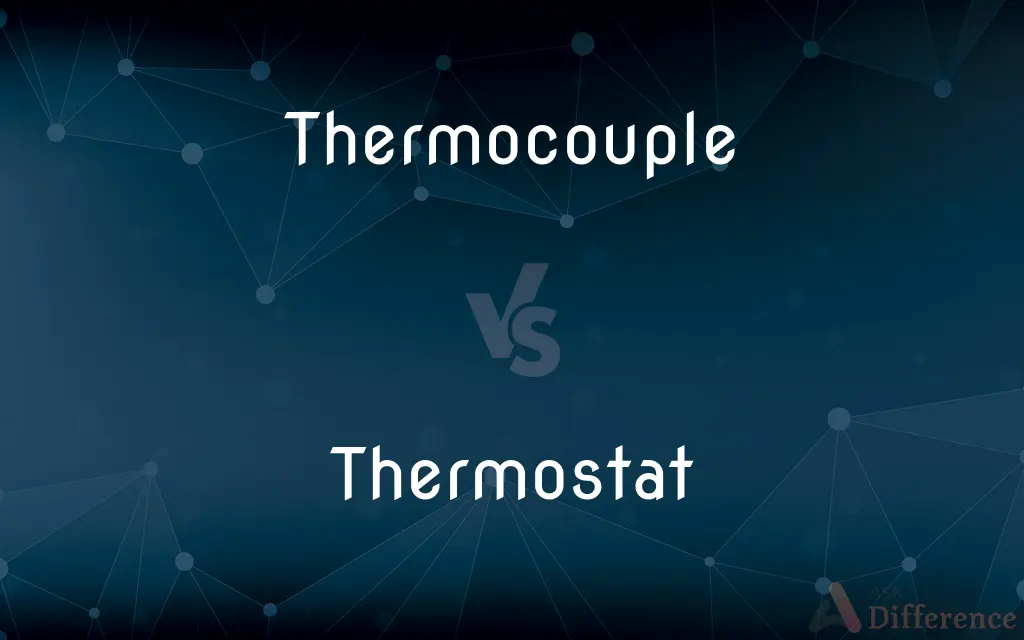Thermocouple vs. Thermostat — What's the Difference?
By Fiza Rafique & Maham Liaqat — Updated on March 6, 2024
A thermocouple measures temperature differences, while a thermostat regulates temperature by turning a system on or off.

Difference Between Thermocouple and Thermostat
Table of Contents
ADVERTISEMENT
Key Differences
A thermocouple is a sensor used to measure temperature gradients, consisting of two dissimilar metal wires joined at one end. When heated, this junction generates a voltage that can be measured and converted into temperature readings. Thermostats, on the other hand, are devices that maintain the desired temperature within an environment by switching heating or cooling systems on or off based on the ambient temperature.
Thermocouples operate based on the thermoelectric effect, which allows them to measure high temperatures directly and with quick response times. They are commonly used in industrial applications. Thermostats, however, rely on the expansion of liquids or bi-metallic strips to sense temperature changes, making them suitable for household and office environments to control HVAC systems.
The accuracy of a thermocouple can vary based on its type (e.g., Type K, J, T) and the operating conditions, but they are generally considered reliable for a wide range of temperatures. Thermostats may not offer the same level of precision but are designed to maintain a set temperature range effectively.
Thermocouples can measure extreme temperatures, from very cold to very hot, making them versatile for different applications. Thermostats are typically used within a narrower temperature range, suitable for human comfort or to protect equipment from overheating or freezing.
While thermocouples provide crucial data for temperature control systems, they do not control heating or cooling equipment directly. Thermostats play a key role in energy management by turning systems on and off to maintain the desired temperature, thus affecting energy consumption and comfort levels.
ADVERTISEMENT
Comparison Chart
Function
Measures temperature differences
Regulates temperature
Principle
Thermoelectric effect
Expansion of materials or electronic control
Application
Industrial, scientific
Residential, commercial
Temperature Range
Wide, from very low to very high
Narrower, suitable for human comfort
Direct Control
No, only measures
Yes, can turn systems on or off
Compare with Definitions
Thermocouple
Can measure extreme temperatures, both high and low.
Thermocouples in cryogenic processes monitor temperatures below -150°C.
Thermostat
A device that maintains desired temperature by controlling heating or cooling systems.
The thermostat turned off the AC as the room reached 22°C.
Thermocouple
A device for measuring temperature made of two different metals joined at one end.
A thermocouple inserted into a furnace measures high temperatures accurately.
Thermostat
Uses sensors to monitor ambient temperature.
A thermostat in the house adjusts the heating to keep the temperature constant.
Thermocouple
Generates a voltage in response to temperature.
The voltage generated by the thermocouple is converted to a temperature reading.
Thermostat
Operates based on the expansion of materials or electronic sensors.
The thermostat's bi-metallic strip expands or contracts to turn the heat on or off.
Thermocouple
Used in industrial settings for temperature monitoring.
Thermocouples ensure the steel is at the right temperature for forming.
Thermostat
Can be programmable for energy efficiency.
The programmable thermostat lowers the heat when no one is home.
Thermocouple
Available in various types for different ranges.
A Type K thermocouple is often used for general purpose temperature measurements.
Thermostat
Found in homes and offices for comfort.
Adjusting the thermostat can make the office more comfortable in winter.
Thermocouple
A thermocouple is an electrical device consisting of two dissimilar electrical conductors forming an electrical junction. A thermocouple produces a temperature-dependent voltage as a result of Seebeck effect, and this voltage can be interpreted to measure temperature.
Thermostat
A thermostat is a regulating device component which senses the temperature of a physical system and performs actions so that the system's temperature is maintained near a desired setpoint. Thermostats are used in any device or system that heats or cools to a setpoint temperature, examples include building heating, central heating, air conditioners, HVAC systems, water heaters, as well as kitchen equipment including ovens and refrigerators and medical and scientific incubators.
Thermocouple
A thermoelectric device for measuring temperature, consisting of two wires of different metals connected at two points, a voltage being developed between the two junctions in proportion to the temperature difference.
Thermostat
A device that automatically regulates temperature, or that activates a device when the temperature reaches a certain point.
Thermocouple
A thermoelectric device used to measure temperatures accurately, especially one consisting of two dissimilar metals joined so that a potential difference generated between the points of contact is a measure of the temperature difference between the points.
Thermostat
A device, as in a home heating system, a refrigerator, or an air conditioner, that automatically responds to temperature changes and activates switches controlling the equipment.
Thermocouple
A kind of thermometer consisting of two wires of different metals that are joined at both ends; one junction is at the temperature to be measured and the other is held at a fixed lower temperature; the current generated in the circuit is proportional to the temperature difference
Thermostat
A regulator for automatically regulating temperature by starting or stopping the supply of heat
Thermostat
Control the temperature with a thermostat
Common Curiosities
Can a thermostat be used for cooling?
Yes, it can control both heating and cooling systems.
What is a thermocouple?
A device that measures temperature by generating a voltage due to the thermoelectric effect of two different metals joined together.
How does a thermostat work?
It regulates the temperature by turning heating or cooling systems on or off based on the ambient temperature.
Where are thermocouples used?
In industrial, scientific, and high-temperature applications.
Can I use a thermocouple for my home oven?
Yes, for measuring temperature, but not for controlling it.
Can I replace a thermostat myself?
Yes, if you follow the manufacturer's instructions and safety guidelines.
Do thermocouples measure temperature or heat?
They measure temperature, not heat directly.
Is a thermocouple accurate?
It is considered reliable for a wide range of temperatures, with accuracy depending on the type and conditions.
What's the difference between a thermostat and a thermometer?
A thermostat controls temperature, while a thermometer measures temperature.
Are thermostats easy to install?
Many are user-friendly, but professional installation may be needed for complex systems.
Can thermostats save energy?
Yes, especially programmable ones, by optimizing heating and cooling schedules.
Do thermocouples need electricity to work?
They generate a small voltage themselves but need external power for the measurement device.
How long do thermocouples last?
Their lifespan varies with usage and environment but can last for years in proper conditions.
Are thermostats accurate?
They are generally accurate enough for controlling home or office environments.
What maintenance do thermostats need?
Periodic cleaning and occasional battery replacement for some models.
Share Your Discovery

Previous Comparison
Culvert vs. Sewer
Next Comparison
Karma vs. RevengeAuthor Spotlight
Written by
Fiza RafiqueFiza Rafique is a skilled content writer at AskDifference.com, where she meticulously refines and enhances written pieces. Drawing from her vast editorial expertise, Fiza ensures clarity, accuracy, and precision in every article. Passionate about language, she continually seeks to elevate the quality of content for readers worldwide.
Co-written by
Maham Liaqat














































